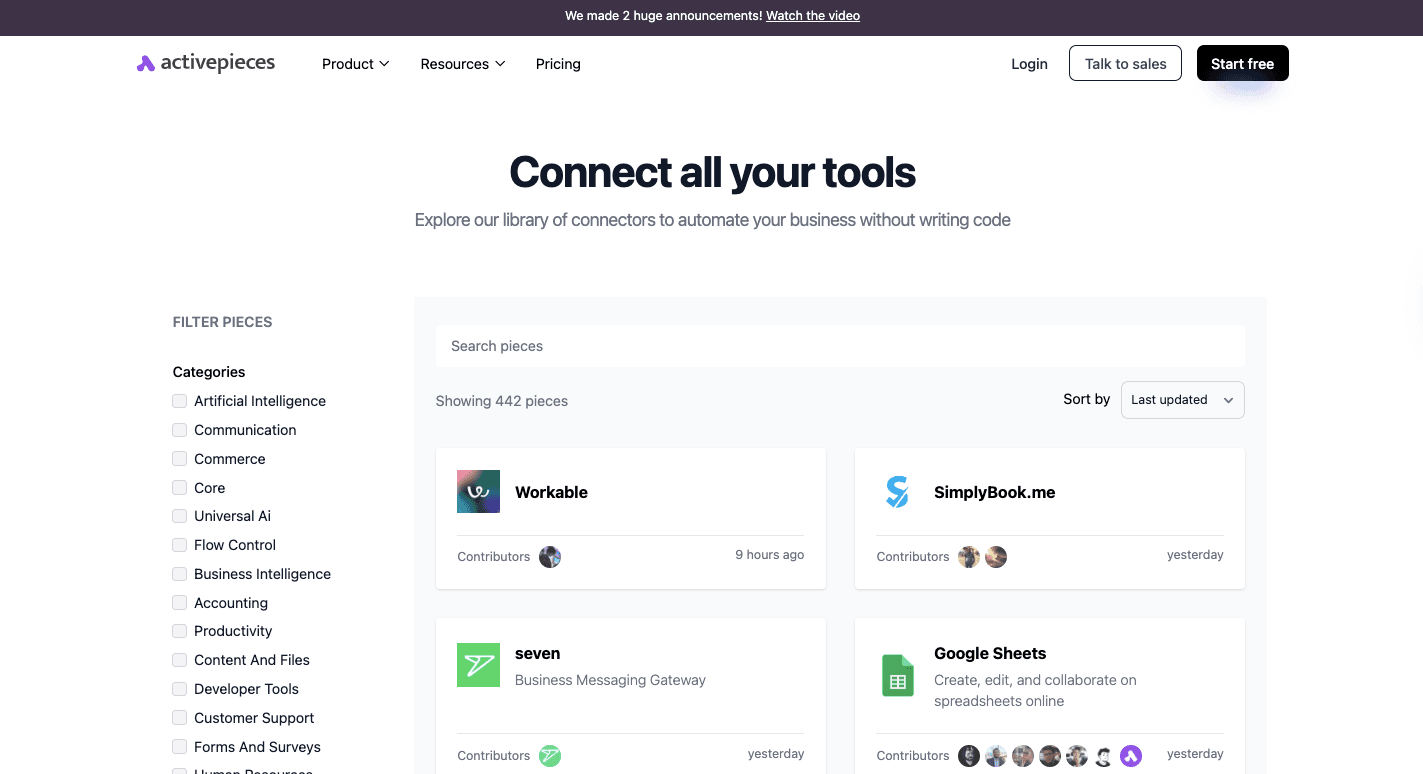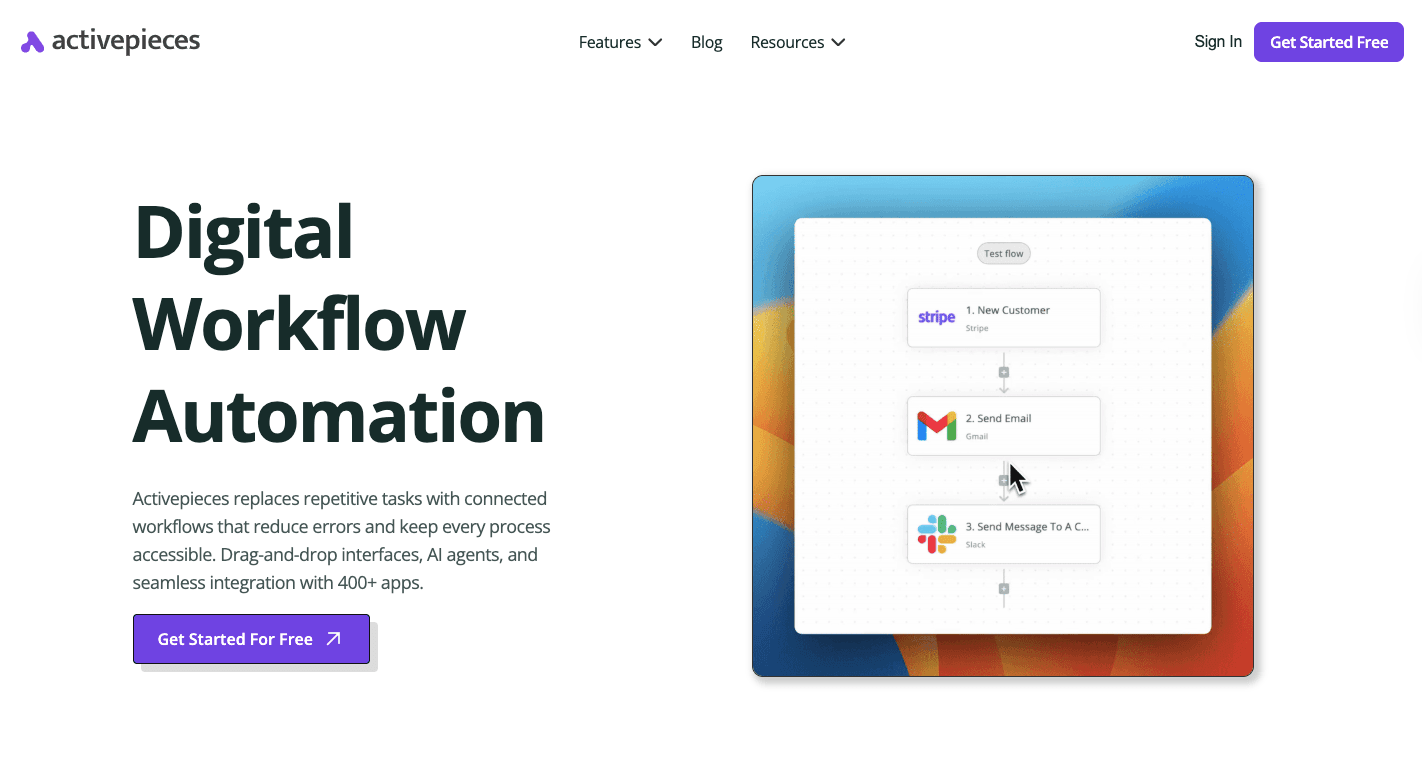Top 10 Business Process Management Challenges (and Fixes)

What started as a system to make work easier now eats up hours of your day. That's why more teams use business process management (BPM) to fix their broken processes and regain control.
But success doesn't happen just because you install new software. Many BPM initiatives fail when integrating BPM with old tools, managing human-driven tasks, or relying on outdated legacy systems.
This article shows how to overcome the biggest business process management challenges and build workflows with Activepieces.
Create your first smart workflow in minutes with Activepieces!
What Is Business Process Management?
Business process management organizes and improves how work gets done across teams. It looks at complete business processes and finds ways to improve and maintain process efficiency.
There are three main types of BPM:
- Human-centric: Centers on approvals, onboarding, and other people-based work.
- Integration-centric: Automates connections between tools like CRMs and ERPs.
- Document-centric: Handles files such as contracts or invoices.
Modern BPM software supports every part of this effort. Using technology like workflow management systems, you can design and track your processes, streamline workflows, and cut down on repetitive work.
AI-driven platforms further manage complex processes more accurately. With machine learning and predictive analytics, you can detect issues earlier and make better decisions.
In short, business process management combines people, systems, and automation to make work structured and measurable for lasting improvement.
Stages of Business Process Management Lifecycle
Every improvement effort in BPM follows a pattern known as the "BPM lifecycle." It's a five-step loop that keeps you learning from your own data and continuously optimizing business processes, such as:
Design
Work begins with identifying what currently happens. Each task, approval, and participant gets mapped out. A process map acts like a snapshot of how work actually flows. Without it, it's impossible to know what to fix.
Model
Once the current flow is documented, you build a version of how it should work. Businesses often use diagrams or BPM software to test possible changes. They can model what happens if one step is automated, a cost is reduced, or a department adds new responsibilities.
Execute
After modeling, the new workflow is put into motion through BPM software. Some companies start small with one team before expanding across multiple departments.
Monitor
Each workflow produces data. Tracking it through reports and data processing reveals where things slow down or break. Key performance indicators guide the review.
Optimize
Improvements come from the insights gathered during monitoring. You might rewrite a policy, add automation, or simplify communication loops. Following this rhythm builds a habit of continuous process improvement that keeps operations lean and effective over time.
10 Common Business Process Management Challenges
Many companies start strong with BPM but have a hard time maintaining momentum for continuous process improvement. Some problems appear early, while others surface after the system scales.
Learning to address BPM challenges helps you stay consistent, save time, and make smarter decisions.
1. Disconnected Systems and Data Silos
Ask anyone who's worked in operations long enough, and they'll tell you the same story. A company starts small with a few tools that work fine together. Then growth hits, and suddenly every team brings in different systems.
When your systems don't connect, your finance sees one version of revenue, sales sees another, and nobody can explain why the numbers don't match. Your team compensates with manual exports and email chains, which only create bottlenecks.
How to Fix Disconnected Systems and Data Silos
Start with one goal: connect everything that matters. A central data platform or warehouse brings all the information together so it's visible in real time.
Companies with older setups often layer in ERP or integration software to connect CRMs, finance tools, and customer databases. Even a partial sync between systems is better than letting your team work blind.
And before anything else, set standards for:
- Accuracy
- Ownership
- Privacy
When key stakeholders agree on definitions and responsibilities, you stop the endless back-and-forth about "which number is right."
2. Manual and Time-Consuming Tasks
Anyone who's ever worked in operations knows how draining repetitive work can be. Hours disappear into spreadsheets, emails, and approvals that could've been handled automatically.
A process that depends too heavily on manual tasks slows everything down. Skilled people end up doing clerical work instead of focusing on ideas, strategy, or customer experience. That imbalance limits how far a company can grow.
The more your team relies on manual work, the harder it becomes to stay accurate. Every extra step means another chance for error, and numbers need constant checking. Decisions take longer as well because managers wait for updates that should already be in front of them.
How to Fix Manual and Time-Consuming Tasks
Small businesses can maximize BPM effectiveness by leveraging robotic process automation (RPA) to eliminate manual tasks, link disconnected systems, and free employees for higher-value work. These tools automate repetitive tasks, cut human error, and accelerate process completion across departments.
The results you'll get include:
- Enhanced efficiency
- Lower costs
- Far fewer bottlenecks
RPA bots can also handle structured, rules-based actions like moving data between systems, generating reports, or sending updates. Pair that with low-code platforms to let non-technical staff build simple automations themselves.
3. Poor Process Monitoring and Visibility

Processes fall apart when people can't see how work moves through them. A report might sit in someone's inbox for days, or a request could stall between two departments with no one noticing.
That lack of clarity spreads quickly. Your teams work from different data sources, so results never quite match. Bottlenecks stay hidden since no one knows where time is being lost.
Without real insight into your process performance, you can never tell whether a new system made things better or worse.
How to Fix Poor Process Visibility and Monitoring
A connected system gives a complete view of your progress and performance. Some BPM initiatives often use monitoring software and process mining tools to trace each step in real time. That kind of detail exposes delays and lets you adjust fast.
After centralizing the data, define what success looks like. Choose a few key performance indicators that match your company's goals, and make them visible to everyone. That will help you turn your progress into something measurable.
Aside from dashboards, you need space to speak up when a workflow breaks down. Regular check-ins, short reviews, and open feedback loops keep information moving freely.
4. Resistance to Change
People form habits around familiar systems, and when those systems change, uncertainty follows. Employees begin to question their place in the new structure and worry that automation might replace their roles. Fear spreads quietly, and job satisfaction across your teams decreases.
McKinsey & Company discovered that 70% of large-scale change efforts fail to meet their goals, and the biggest reason is human resistance. When communication is weak or leadership pushes new systems without involving staff, trust erodes.
Your employees withdraw from discussions and avoid taking part in implementation. That lack of cooperation turns simple updates into long, expensive rollouts.
How to Fix Resistance to Change
A successful BPM rollout starts with transparency. Your employees need to know why the change is happening and how it benefits both the company and their work.
You should communicate early, answer questions honestly, and back up your plans with examples of how similar updates improved other processes.
And to build confidence among your teams to adapt faster and sustain improvements, offer:
- Hands-on sessions
- Ongoing support
- Access to help
Celebrate small wins and highlight early adopters who help others adapt. People respond when their efforts are visible and valued.
5. Legacy Systems and Technical Debt
Many companies still rely on systems built decades ago. Those platforms once supported daily operations, but now they slow progress and complicate every attempt at modernization. Outdated legacy systems often run critical business functions, but can't connect with newer technologies either.
Research from the Software Improvement Group revealed how widespread this problem is. Around 95% of ATM transactions still depend on COBOL, a programming language from the 1950s. And those financial institutions failing to modernize could lose more than $57 billion by 2028.
Those losses come from missed opportunities, inefficient processes, and rising maintenance expenses. The same issue affects other industries where technical debt continues to grow.
Old systems limit how fast an organization can adapt to digital transformation. Then security risks grow as you stop updating your products. Slow data transfer also weakens analytics, which hurts your performance tracking and strategic planning.
How to Fix Legacy Systems and Technology Debt
Modernization works best when it happens in stages. Replacing everything at once often fails because it disrupts ongoing operations. A phased approach allows small, controlled upgrades that reduce risk.
Many companies use the "strangler" pattern, wrapping legacy systems with APIs that slowly replace old functions with modern ones. Microservices follow the same logic by breaking large applications into smaller, independent parts that can evolve over time.
Middleware and data integration tools bridge your old and new systems. Cloud-based solutions like iPaaS platforms or API gateways allow legacy data to connect with modern apps. These connections make it easier to integrate the right BPM software without rebuilding entire infrastructures.
Finally, even a simple rehost can cut maintenance costs, while replatforming enables faster updates and stronger security. Training your staff in cloud-native tools and agile methods keeps modernization sustainable.
Together, these steps remove barriers and rebuild agility across the organization.
6. Lack of Clear Process Ownership
Every business process management effort needs someone accountable for how work moves from start to finish. When that accountability disappears, departments do their parts separately, and no one makes sure that the entire process works as a whole.
For example, an order-to-cash process might involve sales, finance, and operations. Each group manages its section but rarely communicates beyond handoffs. Those gaps lead to misalignment, missed deadlines, and inconsistent results. Processes that span multiple departments can't succeed without someone responsible for connecting the dots.
The lack of ownership also disrupts decision-making. Without process owners, key stakeholders end up debating priorities rather than acting. No one defines success or measures it against strategic objectives, so your teams work hard but not always in the same direction.
Accountability blurs further when leadership changes or projects shift. Over time, that weak link weakens the company's entire organizational structure and turns what should be proactive management into constant firefighting.
How to Fix the Lack of Process Ownership
Every major workflow should have a designated owner with authority to make decisions, assign resources, and measure results. The person chosen should have enough reach to cut through departmental boundaries and keep the process aligned with the company's larger goals.
Other companies often form councils or committees where process owners meet regularly to share progress and solve cross-functional challenges. These sessions reinforce accountability and give you visibility into how changes affect the wider organization.
7. Measuring BPM Success and ROI

Typically, organizations rely only on cost savings and end up overlooking how BPM improves long-term stability and overall business performance. Many teams also start without proper baseline data. If there's no record of how a process performed before optimization, improvement can't be proven later.
Inconsistent or poorly chosen key metrics make it worse, since different departments measure success in different ways. That fragmentation hides progress and weakens credibility when you ask for proof of return.
Timing complicates things, too. Some BPM benefits, like better compliance or a stronger culture, don't appear for months. As a result, projects lose support before their impact is visible.
Yet when BPM programs collect consistent, high-quality data, they uncover data-driven insights that tie operational improvements to strategic outcomes. Those findings reveal the link between process efficiency, decision-making, and profitability.
How to Fix the Challenge of Measuring BPM Success and ROI
Set objectives that connect your process outcomes to your business goals. For instance, when you want to reduce turnaround time, define the target in measurable terms. Link every KPI to a strategic priority, such as:
- Revenue
- Customer satisfaction
- Risk reduction
Establish a solid baseline before any change. Measure cycle times, error rates, and resource use to show the "before" picture. Once new workflows go live, track results against that foundation to quantify progress. BPM dashboards make this simple by displaying real-time data for quick comparisons.
Broaden what you measure afterward. Financial returns matter, but non-financial outcomes, like customer loyalty or employee engagement, often create longer-term value. Pair tangible metrics, such as cost savings, with qualitative ones like service quality or compliance improvements. A balanced view keeps BPM aligned with strategy.
Lastly, review performance quarterly, not just after launch, and adjust KPIs as your company grows.
8. Limited Scalability
A process that worked well for startups breaks once the workload doubles. Business process management was designed to prevent that, but when built on rigid systems, it can turn into another bottleneck.
Older platforms and poor integration make scaling harder. As customer volume rises, workflows slow down, and your team will barely keep up. Legacy infrastructure often lacks the capacity to expand without major investment, so every increase in demand adds cost instead of efficiency.
An early success can collapse when processes remain manual, fragmented, or overly dependent on specific tools.
As your processes fail to grow with your company, innovation slows, and your business growth stalls. Without a scalable design, BPM becomes reactive rather than adaptive.
How to Fix Limited Scalability
The fastest way to strengthen scalability is to move BPM to the cloud. Cloud-based systems adjust resources automatically based on demand, which cuts costs and downtime.
Modern enterprise software uses pay-as-you-go models to expand capacity without the burden of new infrastructure. Updates also roll out faster, so you adapt quickly to new markets or customer needs.
After that, break your workflows into smaller services to prevent any single system from becoming a choke point. To distribute work evenly and simplify upgrades, do:
- Microservices
- Containerization
- Load balancing
With this structure, each component grows independently rather than pulling your whole system down. Documented workflows, cross-trained teams, and process standardization make expansion easier as well.
9. Inconsistent Process Execution
Inconsistency is one of the quietest ways a BPM program fails. Performance drift happens quickly when standards aren't enforced.
New systems make the problem worse if new processes aren't introduced with proper structure. Employees adapt the process design to personal preferences, which creates small variations that multiply across teams.
Those small differences cause rework, confusion, and customer frustration. Without clear guidance, the company spends more time fixing errors than improving performance.
How to Fix Inconsistent Process Execution
Create visual maps that show each task, decision point, and dependency. Store these maps in a central location so everyone works from the same version.
Automation further helps close execution gaps. You can automate routine tasks like entry or reporting. BPM suites and workflow tools, on the other hand, ensure that tasks happen in the right order and that handoffs between departments stay consistent.
Managers should model process discipline by following and reviewing workflows regularly. Comprehensive training must continue after rollout to keep your teams aligned when updates occur.
10. Security and Compliance Risks
Automating workflows and connecting systems improves efficiency, but it also widens the attack surface. When sensitive information moves through multiple applications, even a small oversight can expose your company to data breaches, fraud, or regulatory violations.
Many of these issues stem from weak data quality and poor oversight. When data flows between systems without consistent validation, it's easy for errors to spread across reports, dashboards, and decisions.
In industries handling personal or financial information, one wrong data transfer can trigger privacy violations and penalties. Processes that lack built-in checks make risk management harder and leave companies reacting to problems instead of preventing them.
As workflows grow complex and governance structures remain fragmented, tracking every step becomes difficult, and you can't confirm if your teams ensure compliance with privacy and data protection laws.
How to Fix Security and Compliance Risks
Every new or revised workflow should follow a "security by design" principle, where safeguards are built into process design before rollout. Begin each project with a structured risk assessment that:
- Maps data flows
- Identifies sensitive information
- Checks how each step aligns with regulations such as GDPR or HIPAA
These assessments guide where encryption, access control, and alert systems should be applied.
Modern BPM platforms can further embed business rules directly into workflows so approvals, access restrictions, and audit logs happen automatically. Role-based access ensures that only authorized users can view or modify critical data.
How Activepieces is Changing Business Process Management

Activepieces takes the headache out of automating business workflows. It's open-source and for developers and everyday users who just want things to work without coding for hours.
The platform supports over 442 integrations, called "pieces," that connect CRMs, marketing tools, AI services, and analytics platforms. Each piece is written in TypeScript, so developers can customize every step while non-technical users drag and drop from the no-code builder.
Anyone can also contribute new pieces, which keeps the library expanding and relevant.
It further performs well with your existing systems, such as Slack, Google Sheets, and Microsoft Dynamics. That's how Activepieces helps modern businesses reduce busywork and focus on work that actually grows the company.
Businesses use it to streamline operations, shorten manual processes, and keep automations consistent. It runs just as smoothly on the cloud as it does self-hosted, which gives you total control over data and performance.
Features
Every feature makes automation faster, safer, and more adaptable to your real business needs.
- Open source - Anyone can inspect the code, add features, or adjust workflows for their specific setup.
- AI-ready - Supports AI pieces and SDKs so you can build smart automations that respond and learn over time.
- Community-driven growth - The community contributes over half of the integrations, keeping the ecosystem current and expanding.
- Secure by design - Offers self-hosted and network-gapped deployment options for teams that need tighter control over their data.
- Built in TypeScript - Every integration is a TypeScript package, which makes development faster and easier to maintain.
- No-code builder - Lets you build automations visually while giving developers room for customization.
- Human-in-the-loop options - Supports manual approvals or timed delays for processes that need human review.
Integrations
Right now, Activepieces connects with 442 pre-built integrations across categories that you rely on every day. The integrations, called pieces, make it easy to plug automation into existing tools without needing an engineer to build new connections.

Some you could use:
- OpenAI
- Workable
- Google AI Studio (Gemini)
- ElevenLabs
- Slack
- Discord
- HubSpot
- ClickUp
- Google Sheets
- ActiveCampaign
- WordPress
- Total CMS
- Zoho CRM
- Microsoft Dynamics CRM
The integration library keeps expanding with community contributions. That open, growing structure gives you lasting flexibility to build whatever you need, whenever you need it.
Use Cases
Activepieces fits easily into daily operations. Teams can use it to connect systems, remove busywork, and keep data flowing without interruptions. Marketing departments can automate reporting, schedule posts, and update campaigns in real time.
Meanwhile, sales teams can sync leads from forms to CRMs and send instant alerts when prospects engage. Operations managers then handle approvals, payroll updates, and notifications automatically.
Moreover, Activepieces can:
- Move customer data between systems without manual exports
- Set AI agents to handle chat responses or content summaries
- Update analytics dashboards when new data arrives
- Send real-time alerts for errors, approvals, or sales triggers
Each use case brings automation closer to everyday workflows, so you work faster with fewer mistakes.
Talk to our sales team and find the perfect plan for your automation goals!
Lead the Future of Business Automation With Activepieces

Activepieces removes the barrier between technical and non-technical users and lets anyone build workflows without waiting on developers. The platform runs on open-source technology, which gives you complete control over how you automate.
Developers can customize every integration through TypeScript, while business teams create workflows visually using the no-code builder. Both sides work from the same foundation, which keeps processes unified and simple to manage.
The library currently includes 442 integrations, or "pieces." About half of those were built by the community, so new ones appear all the time. The system runs smoothly with AI automation, too. You can create AI agents or use the built-in Copilot to design flows faster.
There's also an option to self-host or choose a network-gapped setup to keep data private. The platform even supports human input, like approvals or time-based delays, so automation fits your needs.
Take control of your workflows and start automating with Activepieces for free!
FAQs About Business Process Management Challenges
What are the limitations of BPM?
High implementation costs, resistance to change, and dependence on legacy infrastructure can limit business process management (BPM). Poor process modeling often leads to unclear workflows, while complex BPM systems may overwhelm users without proper guidance.
The success of BPM also depends on user adoption, which can lag if employees lack engagement or trust in automation.
What are some of the reasons business process management efforts fail?
BPM efforts often fail when you treat them as a one-time project instead of a continuous improvement cycle. Weak leadership, unclear goals, and poor communication between departments lead to misalignment.
Lack of metrics, outdated tools, and ignoring feedback prevent processes from evolving. Limited investment in analytics tools makes it hard to track performance, too, while an incomplete BPM framework leaves teams without structure.
What are the major challenges involved in business process automation?
Automation challenges include data silos, integration difficulties, and security risks. Some organizations also face job displacement concerns, especially when automation replaces repetitive roles. Others struggle with change management and ensuring that automated systems align with broader business objectives.


